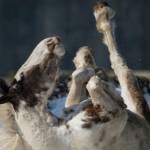Forage Diet May Minimize Colic in Performance Horses

Colic is one of the most common illnesses in horses of all types, with an average rate of about four to five cases per 100 horses per year. Many factors including feed type and schedule, exercise routine, hydration status, turnout time, and dental condition influence colic risk. Horses fed large meals of grain have an increased chance of developing colic, though grain is almost universally added to diets of horses in race training and other high-performance programs to provide necessary levels of energy.
In a study conducted at the Swedish University of Agricultural Sciences, 16 Standardbred horses in training consumed a grain-free diet of high-energy forage to evaluate the effect of this feeding regimen in colic incidence. During the study, Standardbreds performed both high-intensity and low-intensity workouts once or twice a week. The study began when the horses were 1.5 years old and ended when they were four years old. The horses were kept in stalls bedded with shavings/sawdust for 16 hours daily for five days each week and were turned out with access to shelter for the rest of the time. They ate some grass in the paddock during the spring, summer, and fall, and were given free access to a baled grass haylage made from meadow fescue, timothy, and ryegrass at all times. The horses were also given a pelleted alfalfa (lucerne) product with molasses and a mineral and vitamin supplement. Salt and water were always available.
During this study period of 2.5 years, no colic cases were seen during normal management routines. One horse showed mild colic signs after being screened for gastric ulcers with a gastroscope. The researchers suggested that this lack of colic cases during normal management routines could indicate that high-energy forage-only diets might be a good alternative to high-concentrate diets for horses in training.








